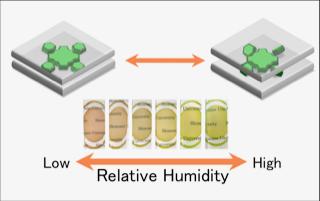TOKYO, June 4, 2018 — Scientists developed a transparent hybrid film and investigated its chromic behavior in relation to relative humidity (RH). The film is made from environmentally friendly clay minerals and a dye, magnesium porphyrin, which changes color in response to environmental humidity.
Combining dyes with a range of natural minerals is a promising strategy for creating hybrid materials that can interact with light, because the physical structure of these natural materials typically features tiny cavities that can hold light-sensitive molecules.

Transparent hybrid film, composed of environmentally friendly clay minerals and dyes, that changes color with humidity. Courtesy of Shinsuke Takagi.
The structure of clay is layered, with nanometer-size spaces between the layers. The spacing between the layers changes in response to changes in RH.
Scientists from Tokyo Metropolitan University and Shimane University placed the dye in the tiny spaces between the layers, and did not allow the dye to aggregate. As the spacing between layers changed in response to RH, so did the confinement of the dye. Specifically, in response to changes in RH, the electrons surrounding the dye molecule, which affect how the molecule interacts with light, lined up with specific chemical groups in the clay, altering its color.
Combining dyes with a range of natural minerals is a promising strategy for creating hybrid materials that can interact with light, because the physical structure of these natural materials typically features tiny cavities that can hold light-sensitive molecules.
Researchers note that changing the color of the material does not involve breaking chemical bonds. This makes a color change easy to reverse and allows the film to undergo repeated switching with minimal degradation.
Both the clay and the dye can be naturally derived and therefore can be used to create a material that is low-cost, safe to use, and compatible with the natural environment. The team hopes to apply the film and the mechanism for changing its color to the development of environmental sensors and the amplification of LEDs for better displays.
The research was published in Langmuir (doi:10.1021/acs.langmuir.7b04006).